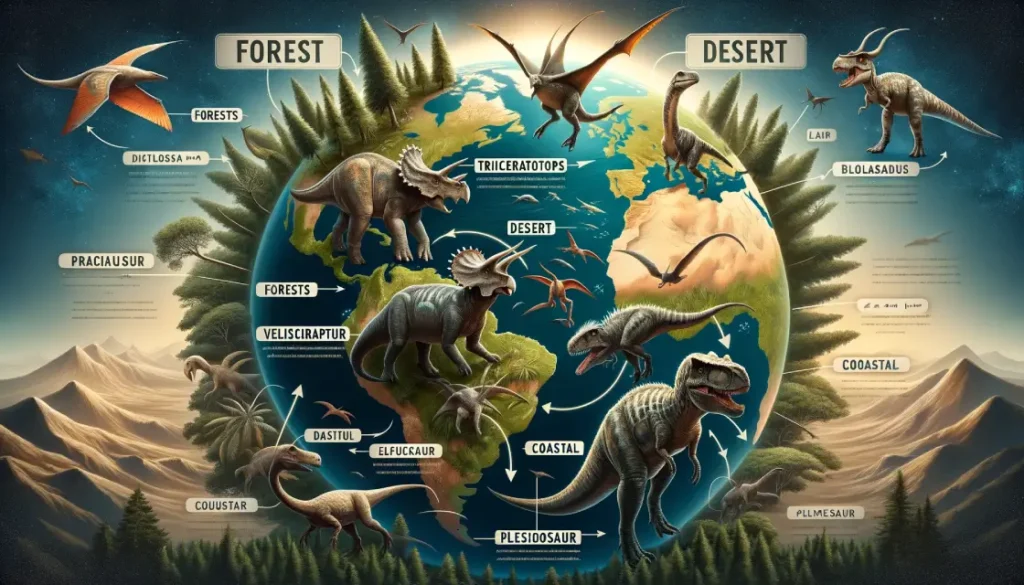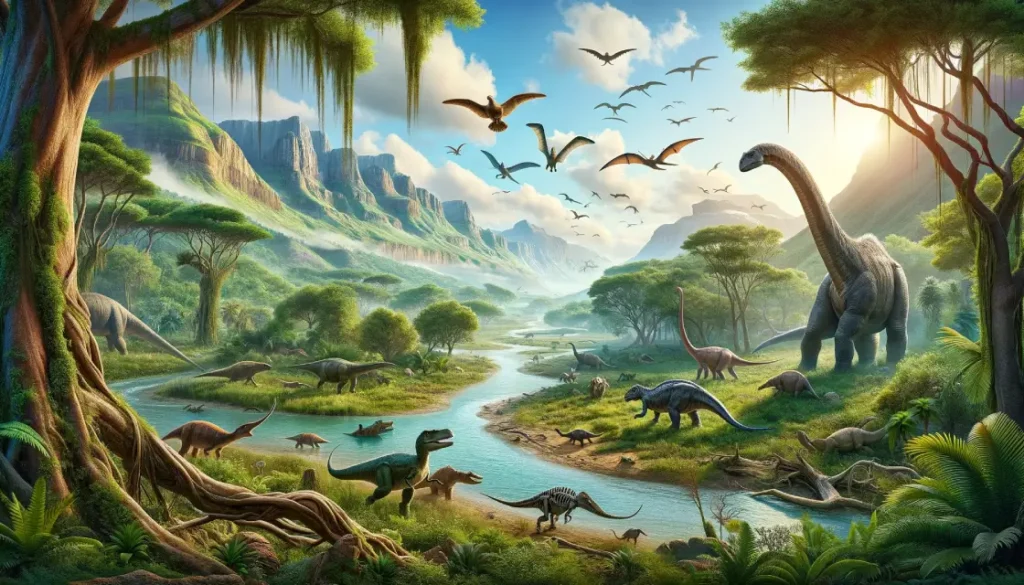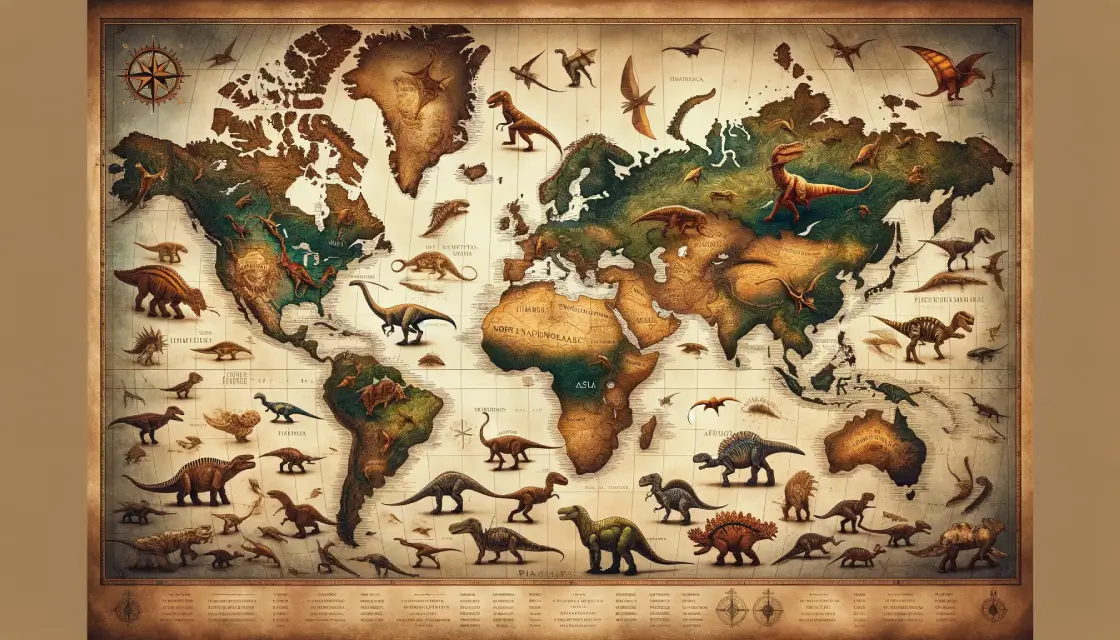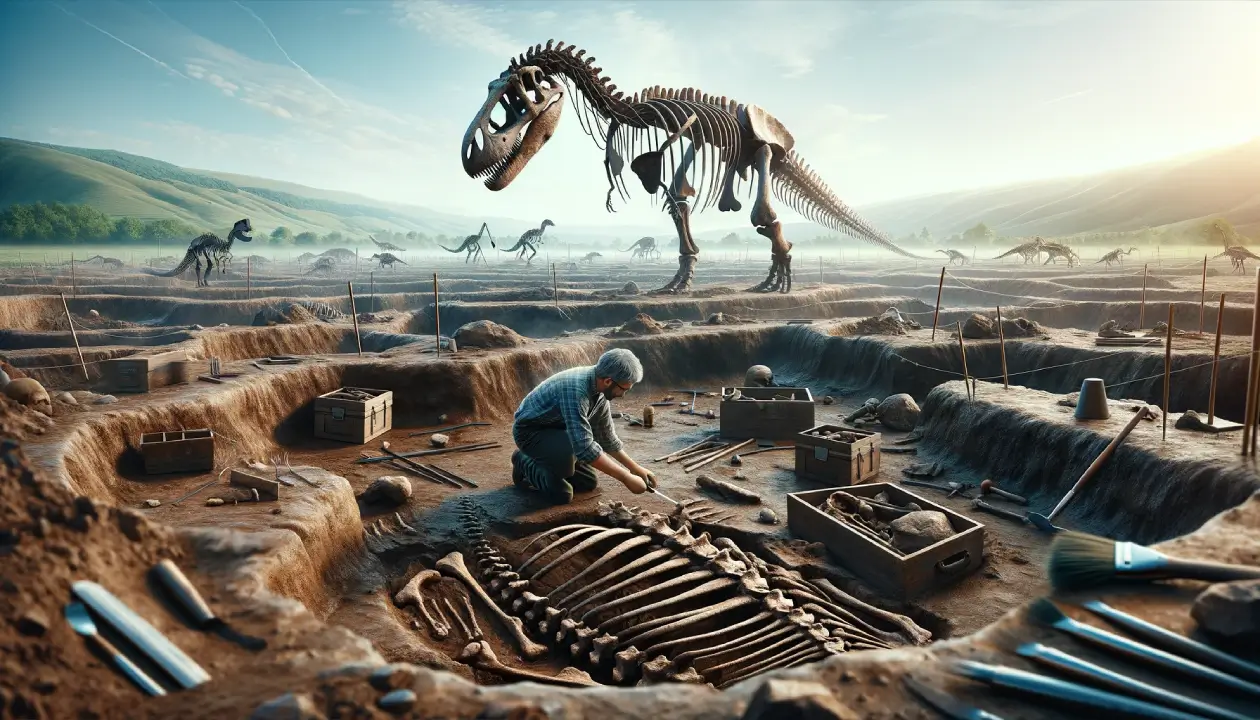Dinosaurs were magnificent creatures that walked the Earth for over 160 million years. Their fossils have been found across the globe, from the driest deserts to the frozen poles. But where exactly did dinosaurs live when they reigned over the planet? Understanding the habitats and geographic ranges of dinosaurs provides insights into how these diverse species evolved and adapted over time. This article will explore the answer to the question: where did dinosaurs live?
| Key Takeaways | Details |
|---|---|
| Dinosaurs lived on every continent | Fossils found on all continents show wide distribution |
| Inhabited diverse environments | Adapted to deserts, forests, swamps, polar regions |
| Lived during the Mesozoic Era | Dominated all habitats on land for over 160 million years |
| Fossils found globally | Major fossil hotspots include Gobi Desert, Western N. America, Patagonia |
| Displayed great adaptability | Thrived in changing habitats and climates across the globe |
Short Answer
Dinosaurs lived on every continent on Earth during the Mesozoic Era, from about 230 to 66 million years ago. They inhabited all types of environments and regions, from lush jungles to arid deserts. The majority of dinosaur fossils have been found in places that were tropical or subtropical when dinosaurs were alive.
Historical Overview
Dinosaurs first emerged during the Triassic period around 230 million years ago and quickly spread worldwide. The Triassic climate was generally hot and dry, with a single massive continent called Pangaea. Early dinosaurs like the prosauropods were well-adapted to semi-arid habitats.
In the Jurassic period that followed, Pangaea broke into continents that began shifting into the configuration we know today. With more coastlines and fluctuating sea levels, swampy jungle regions expanded, supporting giant long-necked sauropods.
During the Cretaceous period, flowering plants diversified, creating new food sources. The climate had tropical and temperate zones, allowing dinosaurs like T. rex to inhabit more northern latitudes.
Geographic Distribution

Fossils show that dinosaurs lived on every continent on Earth. Here are some of the key regions where major dinosaur fossil discoveries have been made:
North America
Many famous dinosaur species come from fossils found in western North America. The Hell Creek Formation in Montana has produced fossils of Triceratops, Tyrannosaurus rex, Ankylosaurus, and Pachycephalosaurus. Other finds include Stegosaurus and Allosaurus from Colorado, Utah, and Wyoming.
South America
The arid deserts of Patagonia in Argentina have yielded fossils of giant sauropods like Argentinosaurus as well as carnivores like Carnotaurus and Abelisaurus. Brazil’s tropical sediments contain fossils of Staurikosaurus, one of the earliest known dinosaurs.
Europe
Numerous important fossils come from the United Kingdom, including Iguanodon, Megalosaurus, and Baryonyx. Fossils of dinosaurs like Archaeopteryx and Compsognathus have been found in what is now Germany.
Africa
The Sahara Desert’s sandstones hold fossils of Ouranosaurus, Carcharodontosaurus, and Spinosaurus. South Africa’s geological formations preserve prosauropods like Massospondylus.
Asia
Mongolia’s Gobi Desert is a treasure trove of fossils, including Velociraptor, Protoceratops, and Oviraptor. China also has many finds, like feathered dinosaurs in the Liaoning Province and sauropods in Sichuan.
Australia
Forests covered Australia when dinosaurs lived there. Key fossils include Muttaburrasaurus, known from nearly complete skeletons.
This wide distribution shows how dinosaurs adapted to thrive in diverse environments worldwide. From deserts to rainforests to polar regions, dinosaurs could be found across the globe.
| Continent | Example Species |
|---|---|
| North America | Triceratops, T. rex |
| South America | Abelisaurus, Carnotaurus |
| Africa | Spinosaurus, Ouranosaurus |
| Europe | Iguanodon, Archaeopteryx |
| Antarctica | Cryolophosaurus |
| Asia | Velociraptor, Psittacosaurus |
| Australia | Muttaburrasaurus |
The table above summarizes the wide geographic distribution of dinosaurs based on major fossil finds on each continent. This distribution reflects how dinosaurs adapted to many different environments globally.
Habitat Diversity
Beyond just continents, dinosaurs inhabited diverse environments and ecologies globally. Some key dinosaur habitats included:
- Coastlines/swamps: Nearshore swampy regions allowed giant sauropods like Apatosaurus to thrive on abundant vegetation.
- Jungles: Tropical jungles sustained diverse dinosaurs in places like prehistoric China.
- Floodplains: Open floodplains had herds of grazing ornithopods and ceratopsians.
- Deserts: Arid deserts hosted tough ornithischians adapted to dry conditions.
- Polar regions: Cooler temperatures near the poles supported dinosaurs like Cryolophosaurus.
| Habitat | Example Species |
|---|---|
| Coasts/Swamps | Apatosaurus |
| Jungles | Mamenchisaurus |
| Floodplains | Parasaurolophus |
| Deserts | Ouranosaurus |
| Polar Regions | Cryolophosaurus |
This habitat diversity demonstrates the ability of dinosaurs to adapt and thrive in ecosystems worldwide. From lush jungles to arid deserts, dinosaurs occupied many ecological niches globally during their long reign.
Examples of Dinosaurs and Their Habitats

Many dinosaurs are strongly associated with the regions their fossils have been found in. Here are some examples:
- Tyrannosaurus rex: This famous meat-eater lived in subtropical forests in western North America during the late Cretaceous period.
- Velociraptor: This small feathered carnivore inhabited desert environments in ancient Mongolia.
- Brachiosaurus: One of the tallest sauropods, it lived in Jurassic forests of North America.
- Spinosaurus: The largest carnivorous dinosaur, it resided in swamps and river systems in Africa.
- Muttaburrasaurus: Herds of this ornithopod browsed vegetation in Australia’s forested ecosystems.
- Iguanodon: This early ornithopod was widespread across Europe’s tropical islands and swamps.
| Habitat | Example Genera |
|---|---|
| North American forests | T. rex, Triceratops, Edmontosaurus |
| Asian deserts | Velociraptor, Protoceratops, Oviraptor |
| African swamps | Spinosaurus, Carcharodontosaurus, Ouranosaurus |
| European islands | Iguanodon, Megalosaurus, Baryonyx |
| Australian forests | Muttaburrasaurus, Minmi |
This table summarizes some of the most famous dinosaur genera sorted by the habitats their fossils have been found preserved in.
Interesting Facts
- Dinosaurs lived on Earth for over 160 million years. Humans have only been around for about 300,000 years.
- Some dinosaurs were found in polar regions, showing they could adapt to cold climates.
- Fossil evidence shows dinosaurs lived on every continent, including Antarctica.
- While many lived in tropical or subtropical habitats, some dinosaurs were found in the arid Gobi Desert.
- Entire dinosaur ecosystems have been excavated from fossil sites like the La Brea Tar Pits.
- Some migratory dinosaurs like sauropods traveled hundreds of miles seasonally.
- Dinosaurs dominated on land but also adapted to marine and aerial environments.
- Dinosaurs inhabited diverse environments worldwide, from forests to swamps to floodplains.
Conclusion
In summary, dinosaurs were globally distributed and inhabited nearly every type of terrestrial environment and ecology during their reign. Fossil evidence shows dinosaurs lived on every continent, including Antarctica.
While most remains are found in tropical or subtropical sediments, dinosaurs clearly thrived in arid deserts, coastal swamps, inland floodplains, dense forests, and even polar regions.
Major dinosaur fossil hotspots include the Gobi Desert, Patagonia, the Western United States, and China. However, fragments of these iconic animals are found worldwide. This broad habitat diversity reflects the ability of dinosaurs to adapt and evolve as environments changed over the Mesozoic Era.
Their distribution across geographic areas and ecological niches ultimately enables us to answer the question – where did dinosaurs live? The answer is nearly everywhere on Earth! By mapping and studying their remains, we gain better insights into dinosaur behavior, physiology, and the prehistoric worlds they dominated.









